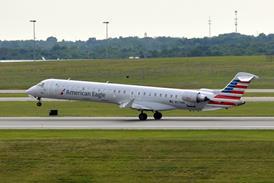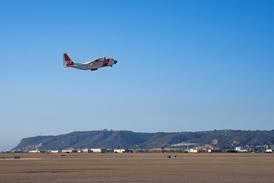GUY NORRIS / MOJAVE
Maker says follow-on programme requires $850,000 to enter next phase and $10m to become service-ready
California-based XCOR Aerospace, developer of re-usable commercial rocket engines, demonstrated its EZ-Rocket testbed aircraft in the Mojave Desert on 12 November as part of efforts to raise additional investment for a follow-up sub-orbital vehicle.
The EZ-Rocket, a highly-modified Rutan-designed Long-EZ aircraft, is powered by two XCOR XR-4A3 liquid-fuelled rocket engines.
Each rocket is regeneratively cooled, and is capable of producing up to 400lb thrust (1.8kN) using a combination of isopropyl alcohol, housed in an external composite tank below the aircraft, and internally mounted tanks of liquid oxygen (LOx).
This configuration can carry up to 68kg (150lb) of alcohol and 136kg of LOx. XCOR chief executive Jeff Greason says the EZ-Rocket is "an operational demonstrator" which has been designed to prove that rocket-powered aircraft can be used "safely and routinely".
"We need more capital in the bank before we complete the total package. We're looking for around $850,000 to get us through to the next phase," says Greason. XCOR estimates that approximately "$10 million will be needed to get a revenue-generating vehicle through flight tests and ready for service".
The operational XCOR vehicle is to be powered by up to four 1,500lb-thrust rockets, and will be capable of sub-orbital altitudes well in excess of 260,000ft (79,000m). Entry into service is expected as early as the end of 2004, adds Greason.
The vehicle would be a platform for micro-gravity experiments, the release of orbital micro-satellite payloads with an upper stage, and possibly the carriage of passengers, he says. Work on scaling up the current 400lb-thrust rocket engines is planned to go ahead in parallel with the design of the larger operational vehicle.
The integrated airframe design work is expected to take place in partnership with other companies and subcontractors. "We are glad to supply engines, but the vehicle market for this is not mature, so we are compelled to get into the aircraft-integration business as well," says Greason.
The current flight test series is scheduled to be completed by mid-2002, with the emphasis shifting increasingly to design and testing of thermal protection and other advanced systems.
XCOR's design team, which was formerly employed at the defunct Rotary Rocket company, first fired its own motor (a 160lb-thrust unit) in October last year, and began firing the more powerful XR-4A3in January.
It is working on at least two other propulsion development efforts under separate contracts. First flight of the engine on the EZ-Rocket was made on 10 September.
The latest flight reached an altitude of more than 8,000ftand speeds of more than 180kt (330km/h) before the propellants were consumed and the aircraft glided back for landing.
Source: Flight International























